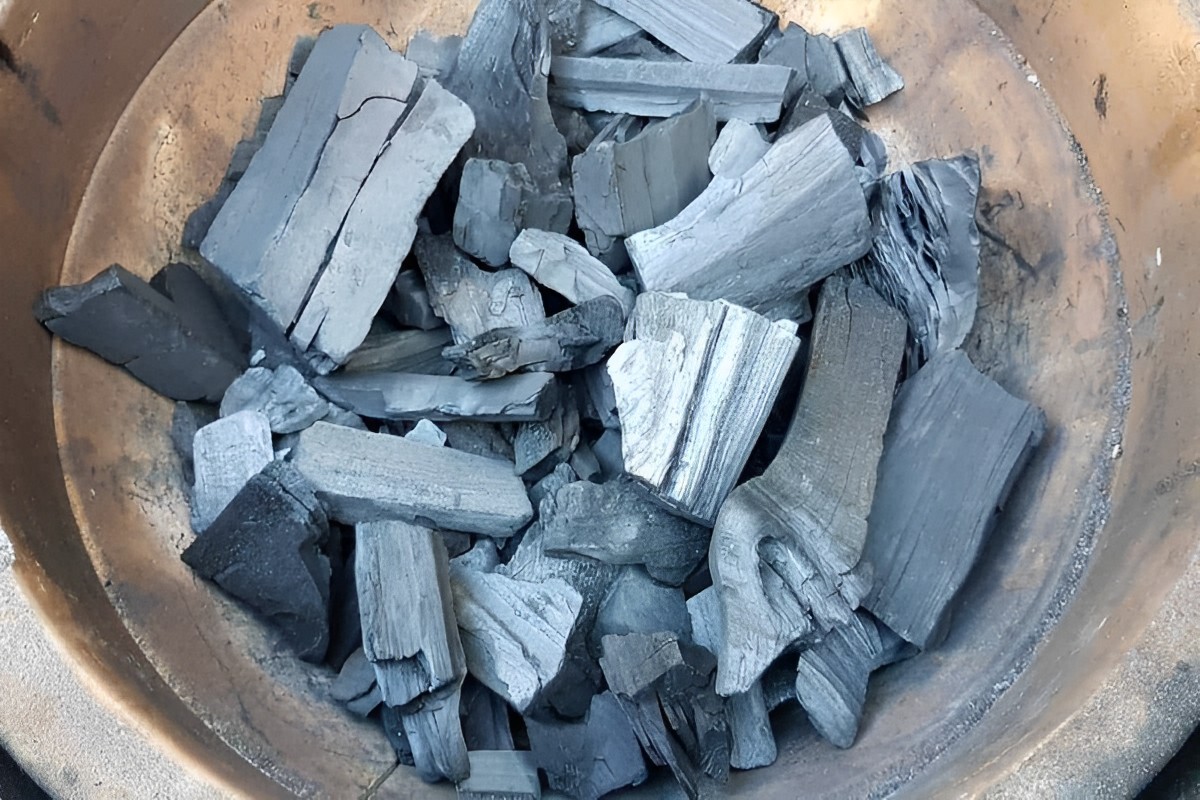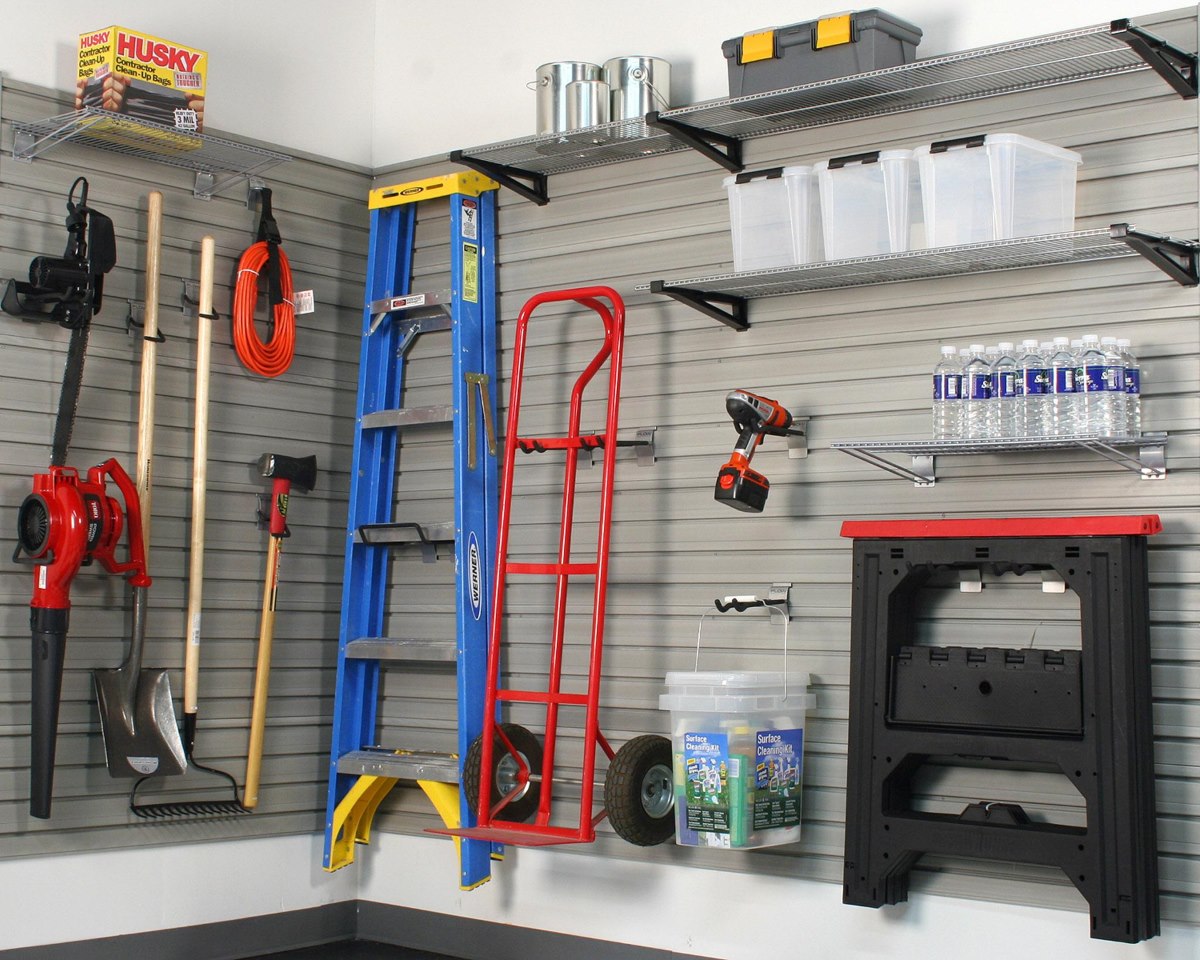

Articles
How To Store Coal
Modified: December 7, 2023
Learn the best methods for storing coal with our informative articles. Proper storage techniques ensure its longevity and efficiency.
(Many of the links in this article redirect to a specific reviewed product. Your purchase of these products through affiliate links helps to generate commission for Storables.com, at no extra cost. Learn more)
Introduction
Storing coal properly is crucial for ensuring its longevity and usability. Whether you use coal for cooking, heating, or any other purpose, proper storage techniques are essential to maintain its quality and effectiveness. In this article, we will delve into the various aspects of coal storage, including safety precautions, storage options, choosing the right containers, handling and transportation, long-term storage tips, and maintenance.
Coal, a combustible black or brownish-black sedimentary rock, is primarily composed of carbon, along with various other elements such as hydrogen, sulfur, oxygen, and nitrogen. It is a valuable energy resource that has been used for centuries in various industries and households around the world.
The first step in understanding how to store coal effectively is to comprehend its nature. Coal is highly susceptible to moisture, which can lead to deterioration, spoilage, and the formation of mold and fungus. Additionally, exposure to air and sunlight can cause the coal to lose its combustibility over time.
Furthermore, it is important to note that improperly stored coal can pose serious health and safety risks. The release of coal dust particles into the air can lead to respiratory issues and other health complications. Moreover, the spontaneous combustion of coal in confined spaces can result in fires and explosions.
With these factors in mind, we must take appropriate measures to ensure the safe and proper storage of coal. In the following sections, we will explore the necessary precautions and techniques for storing coal both indoors and outdoors, along with guidelines for selecting the most suitable containers for storage.
Moreover, we will provide insights into the proper handling and transportation of coal to minimize the risk of accidents or damage to the stored coal. Additionally, we will share tips for long-term storage, which will be particularly beneficial if you plan to store coal for an extended period.
Lastly, we will discuss the importance of regular maintenance and cleaning of the coal storage area to prevent the buildup of dust, debris, and potential hazards. By following the recommendations outlined in this article, you can ensure that your coal remains in optimal condition and performs effectively whenever you need it.
Key Takeaways:
- Proper coal storage is crucial for maintaining quality and safety. Understanding coal’s nature, implementing safety precautions, and choosing suitable storage options are essential for effective storage.
- Long-term coal storage requires careful attention to moisture, temperature, and cleanliness. Regular maintenance, proper handling, and adherence to safety measures are vital for preserving coal quality.
Read more: How To Store Store-Bought Bread
Understanding the Nature of Coal
Before delving into the storage techniques for coal, it is important to have a basic understanding of its nature and characteristics. Coal is primarily composed of carbon, formed from ancient plant material that underwent a process of decomposition and compaction over millions of years.
There are different types of coal, classified based on its carbon content and energy potential. The four main types are anthracite, bituminous, sub-bituminous, and lignite. Anthracite is the highest rank of coal with the highest carbon content, resulting in a high energy yield. Bituminous coal is the most common type and is widely used for various purposes. Sub-bituminous and lignite coals have lower carbon content and are typically used in power generation.
When it comes to storage, two factors play a crucial role in maintaining coal’s quality and usability: moisture content and exposure to air and sunlight. Coal has a natural affinity for moisture, and excessive moisture can lead to mold growth, deterioration, and reduced combustibility. Therefore, it is essential to keep coal as dry as possible during storage.
Exposure to air and sunlight can cause the coal to oxidize, resulting in the loss of its combustibility. Oxidation is a chemical reaction that occurs when coal reacts with oxygen, breaking down its carbon bonds and reducing its energy content. This process is more likely to occur with smaller coal particles, which have a larger surface area and are more susceptible to oxidation.
Furthermore, coal can release small particles of dust and fine particles when handled or stored improperly. These particles, known as coal dust, can pose serious health risks when inhaled, as they can cause respiratory issues, including coal workers’ pneumoconiosis (CWP), commonly known as “black lung” disease.
Understanding these characteristics of coal is vital for implementing effective storage techniques. By minimizing moisture, preventing exposure to air and sunlight, and addressing the issue of coal dust, we can ensure that the stored coal remains usable and safe for its intended purposes.
Safety Precautions for Storing Coal
Storing coal safely is of paramount importance to prevent accidents, health hazards, and damage to the stored coal. By following the necessary safety precautions, you can ensure the well-being of yourself, others, and the surrounding environment. Here are some essential safety measures to keep in mind when storing coal:
- Ensure proper ventilation: Adequate ventilation is crucial when storing coal to minimize the risk of buildup of coal dust and the accumulation of combustible gases. Proper airflow helps to maintain the coal’s quality and reduces the potential for fires or explosions. Install ventilation systems or ensure that the storage area has sufficient natural airflow.
- Keep storage area clean and free from debris: Regularly clean the coal storage area to remove dust, debris, and any other potential fire hazards. A clean storage area also reduces the risk of contamination and mold growth. Use appropriate cleaning methods, such as sweeping or vacuuming, to prevent the dispersion of coal dust particles.
- Store coal away from flammable materials: Keep the storage area separate from flammable materials, including gasoline, propane, chemicals, and other combustible substances. This separation helps prevent accidental ignition or combustion of these materials due to the heat generated by the coal or potential sparks during handling.
- Implement good housekeeping practices: Maintain a well-organized storage area, ensuring that coal is stacked securely and compactly to prevent collapses or shifting. Label the storage containers or piles clearly to identify the type of coal, its origin, and the date of storage. This organization facilitates easy access during usage and helps minimize the risk of accidents.
- Use proper personal protective equipment (PPE): When handling or working in the vicinity of stored coal, wear appropriate PPE to protect yourself from potential hazards. This may include safety goggles, masks, gloves, and respiratory protection to minimize exposure to coal dust and mitigate respiratory issues.
- Ensure proper fire safety measures: Have adequate fire suppression equipment, such as fire extinguishers, sprinkler systems, and smoke detectors, in or near the coal storage area. Educate yourself and others about fire safety protocols and emergency procedures in case of fire or other accidents.
- Adhere to local regulations and guidelines: Follow the applicable local regulations and guidelines regarding the storage of coal. These regulations may include restrictions on the maximum quantity of stored coal, specific storage requirements, and safety standards.
Remember, safety should always be the top priority when storing coal. By implementing these precautions and being aware of potential hazards, you can minimize risks and ensure a safe environment for everyone involved.
Indoor Storage Options
When it comes to storing coal indoors, there are several options available, each with its own advantages and considerations. The choice of storage option depends on factors such as the available space, the quantity of coal to be stored, and the intended use of the coal. Here are some indoor storage options to consider:
- Coal Bin: A coal bin is a dedicated storage container designed specifically for storing coal. It is typically a large, sturdy container made of metal, plastic, or concrete. A coal bin offers a secure and organized storage solution and helps protect the coal from moisture, air, and external contaminants. It is important to ensure that the bin has proper ventilation to prevent the buildup of gases and allow airflow.
- Coal Room: If you have ample indoor space, you can allocate a whole room for coal storage. This option is particularly suitable for larger quantities of coal. The coal room should be well-ventilated and isolated from other areas to reduce the risk of dust contamination and fire hazards. Consider using racks or shelving units to stack the bags or containers of coal neatly, allowing for easy access and inventory management.
- Coal Closet or Storage Cabinet: If space is limited, you can designate a closet or cabinet specifically for coal storage. Ensure that the closet or cabinet has proper ventilation and is away from flammable materials. Use sturdy shelves or bins to stack the bags or containers of coal efficiently. It is important to choose a closet or cabinet with solid construction that can withstand the weight of the stored coal.
- Basement or Garage: If you have a basement or garage, they can be viable options for indoor coal storage. However, it is crucial to consider the ventilation and moisture issues typically associated with these areas. Ensure that the basement or garage has proper airflow to prevent the accumulation of gases and excess moisture. Consider using containers or bins with lids to protect the coal and minimize dust dispersion.
- Utility or Storage Room: If you have a utility or storage room in your house, it can be repurposed for coal storage. Ensure that the room is isolated and well-ventilated, and take necessary precautions to prevent dust accumulation. Properly label the containers or bags of coal to maintain organization and easy access.
Regardless of the indoor storage option you choose, it is essential to keep the area clean, organized, and free from potential hazards. Regularly inspect the storage area for any signs of moisture, mold, or damage to ensure the quality and safety of the stored coal.
Remember to consult local regulations and guidelines regarding indoor coal storage to ensure compliance and safety. By selecting the appropriate indoor storage option and following proper storage practices, you can maintain the quality and usability of your stored coal.
Outdoor Storage Solutions
If you have limited indoor space or prefer to store coal outside, there are several outdoor storage solutions to consider. However, it is important to note that outdoor coal storage comes with additional challenges, such as exposure to the elements and the need for enhanced protection against moisture and contamination. Here are some outdoor storage solutions for coal:
- Coal Shed: A coal shed is a purpose-built structure for outdoor coal storage. It provides a dedicated space for storing a large quantity of coal while protecting it from the elements. A well-constructed coal shed should have a waterproof roof, proper ventilation, and solid walls to minimize moisture and prevent coal dust dispersion. Consider using pallets, tarps, or plastic sheets to further protect the coal from rain or snow.
- Storage Containers or Bins: If you do not have a dedicated coal shed, you can utilize storage containers or bins designed for outdoor use. These containers are typically made of durable materials like plastic or metal and offer protection against moisture and external contaminants. Choose containers with tight-fitting lids to prevent water penetration and secure latches to deter unauthorized access.
- Tarps or Covers: If you have a designated outdoor area for coal storage, you can use tarps or covers to protect the coal from direct exposure to rain, snow, or sunlight. Ensure that the tarps or covers are securely fastened to prevent them from being blown off by strong winds. Consider using bungee cords or ropes to secure the covers tightly.
- Piles or Stacks: If you have a large open space, you can create coal piles or stacks for outdoor storage. However, this option requires careful planning and consideration. Make sure to choose a location with good drainage to avoid water accumulation around the coal. Consider covering the top of the pile with a waterproof tarp or plastic sheet to protect it from rain while allowing for proper ventilation.
- Coal Storage Silo: For industrial or large-scale coal storage, a coal storage silo can be a suitable solution. These cylindrical structures are specifically designed for storing bulk quantities of coal. They offer protection against moisture, assist in segregating different types of coal, and provide efficient loading and unloading mechanisms. Consult with professionals or suppliers to determine the optimal design and size for your specific requirements.
When opting for outdoor coal storage, it is crucial to consider the local climate and weather conditions. Extreme temperatures, high humidity, or frequent rainfall can have a significant impact on the integrity and quality of the stored coal. Regularly inspect the storage area, monitor moisture levels, and take appropriate measures to prevent water penetration and mold growth.
Remember to adhere to any local regulations or guidelines regarding outdoor coal storage, including the maximum quantity of coal allowed and any specific requirements for storage structures. By selecting the right outdoor storage solution and implementing proper protective measures, you can ensure that your coal remains in good condition and ready for use when needed.
Store coal in a dry, well-ventilated area to prevent it from absorbing moisture and becoming less effective as a fuel. Keep it covered to protect it from the elements and store it away from any sources of heat or open flame.
Read more: How To Store Basil From Grocery Store
Choosing the Right Container for Coal Storage
Selecting the appropriate container for storing coal is essential to maintain its quality, protect it from moisture and contamination, and ensure ease of handling. The right container should be durable, well-sealed, and suitable for the quantity and type of coal you intend to store. Here are some factors to consider when choosing a container for coal storage:
- Material: Choose a container made of a material that is resistant to moisture and sturdy enough to withstand the weight and handling of coal. Common options include plastic, metal (such as galvanized steel or aluminum), or concrete. Each material has its own advantages and considerations, so assess your needs and preferences to determine the most suitable choice.
- Sealing: Ensure that the container has a tight and secure seal to prevent moisture from entering and damaging the coal. A well-sealed container also helps contain coal dust and reduces the risk of contamination. Look for containers with reliable lids, latches, or closures that provide an effective barrier against water and air.
- Size and Capacity: Consider the quantity of coal you plan to store and choose a container with an appropriate size and capacity. It should be spacious enough to accommodate the coal comfortably and allow for easy access during usage. Keep in mind that overfilling a container can lead to poor ventilation and increased risk of moisture buildup.
- Portability: If you need to transport the coal or move it around regularly, consider containers with handles or wheels for ease of mobility. This feature can facilitate the loading, unloading, and transportation of coal without straining your back or causing unnecessary inconvenience.
- Ventilation: While airtight sealing is important for preventing moisture, some ventilation is necessary to allow for proper airflow and reduce the risk of gas buildup. Look for containers that incorporate ventilation features, such as small vents or perforations, to facilitate air circulation without compromising the seal’s effectiveness.
- Stackability: If you plan to stack multiple containers, ensure that they are designed to be stackable. Containers with a flat and stable base, reinforced corners, and interlocking features allow for secure stacking without the risk of collapsing or shifting. This maximizes the use of space and improves organization in your storage area.
Remember to label the containers clearly with relevant information, such as the type of coal, its origin, and the date of storage. This labeling helps with inventory management, easy identification, and ensures that the coal is used in the proper order to maintain freshness.
Additionally, it is crucial to regularly inspect the containers for any signs of damage, wear, or weakened seals. Replace any defective containers to maintain the integrity and effectiveness of the storage system.
By considering these factors and choosing the right container for coal storage, you can ensure that your coal remains protected, well-organized, and readily accessible whenever you need it.
Proper Handling and Transportation of Coal
When it comes to handling and transporting coal, it is important to follow proper procedures to ensure the safety of both individuals involved and the coal itself. Improper handling and transportation can lead to accidents, injuries, and damage to the coal. Here are some guidelines to ensure the proper handling and transportation of coal:
- Personal Protective Equipment (PPE): Wear appropriate personal protective equipment (PPE) when handling coal. This may include safety goggles, masks or respirators, gloves, and sturdy footwear. PPE helps protect against potential hazards such as coal dust, sharp edges of coal or containers, and potential spills.
- Proper Lifting Techniques: When lifting bags or containers of coal, use proper lifting techniques to prevent strains and injuries. Bend at the knees and lift with your legs, rather than your back. Avoid twisting your body while lifting and use assistance or equipment if necessary for heavy loads.
- Secure Packaging and Fastening: Ensure that bags or containers of coal are securely packaged and fastened before transportation. Loose packaging can lead to spills, contamination, and difficulties during handling. Use straps, ropes, or pallets to secure the load and prevent shifting or falling during transportation.
- Appropriate Vehicle: Use a suitable vehicle for transporting coal, considering the quantity and type of coal being transported. The vehicle should be structurally sound and equipped with appropriate restraints or containers to prevent movement during transit. Avoid overloading the vehicle beyond its capacity to maintain stability and prevent accidents.
- Adhere to Traffic and Transportation Regulations: Follow local traffic rules and transportation regulations when transporting coal. Observe speed limits, use appropriate signals, and secure the load according to local guidelines. This ensures not only your safety but also the safety of other road users.
- Avoid Stacking Coal Bags Too High: When stacking bags of coal, avoid stacking them too high, as it can lead to instability and the risk of collapse. The stack should be secure and well-balanced, allowing for easy handling and unloading without causing accidents or damage.
- Keep Coal Away from Ignition Sources: During transportation, keep coal away from potential ignition sources, such as open flames, sparks, or electrical equipment. Avoid smoking near the coal and ensure that the transport vehicle is in good condition, with no fuel or oil leaks that could come into contact with the coal.
- Be Mindful of Environmental Considerations: When transporting coal, be conscious of environmental considerations, such as preventing coal dust from dispersing into the air or contaminating bodies of water. Minimize dust emissions by covering the load and adopting appropriate measures to reduce dust generation, such as using water sprays or dust suppression agents if necessary.
Additionally, regular maintenance and inspections of transport vehicles are crucial to ensure their safe operation. Check tires, brakes, lighting, and other essential components before each trip to prevent potential issues that could compromise safety.
By following these guidelines and exercising caution during the handling and transportation of coal, you can minimize the risk of accidents, preserve the quality of the coal, and contribute to a safe and efficient process.
Tips for Long-term Coal Storage
If you plan to store coal for an extended period, proper storage techniques are crucial to maintain its quality and usability. Long-term coal storage requires extra care to prevent moisture buildup, oxidation, and deterioration. Here are some tips to help you effectively store coal for the long term:
- Keep coal dry: Moisture is the primary enemy when it comes to long-term coal storage. Ensure that the storage area is dry and well-ventilated. Avoid storing coal in areas prone to leaks or excessive humidity. Consider using dehumidifiers or moisture absorbers, especially in areas with high humidity, to minimize moisture-related issues.
- Rotate coal stock: Implement a “first in, first out” (FIFO) system to prevent coal from sitting in storage for too long. This system involves using the oldest coal first, ensuring that the stored coal is used in a timely manner and reducing the chances of deterioration due to prolonged storage.
- Inspect for signs of deterioration: Regularly inspect the coal for any signs of deterioration, such as mold, discoloration, or foul odors. If you notice any indications of spoilage, remove the affected coal immediately to prevent contamination and deterioration of the remaining stock.
- Monitor temperature: Keep an eye on the temperature of the storage area. Fluctuations in temperature can lead to condensation, which can contribute to moisture buildup. Maintain a relatively stable temperature within the storage space to minimize the risk of moisture-related problems.
- Avoid exposure to sunlight: Shield the stored coal from direct sunlight, as prolonged exposure can result in the loss of combustibility. If storing coal outdoors, use tarps, covers, or sheds to provide shade and protect it from excessive sunlight.
- Check for pests: Inspect the storage area for signs of pests, such as rodents or insects, which can damage the coal and contaminate the storage area. Take appropriate measures to prevent infestations, such as sealing any entry points and using pest control methods if necessary.
- Minimize dust accumulation: Dust can accumulate over time and affect the quality of stored coal. Regularly clean the storage area to minimize dust buildup. Use appropriate cleaning methods, such as sweeping or vacuuming, to prevent the dispersion of dust particles.
- Organize and label: Maintain an organized storage system by stacking the coal neatly and labeling containers or bags with relevant information like the type of coal and the date of storage. This organization makes it easier to access specific batches of coal and ensures the proper utilization of stored coal.
- Keep an inventory: Maintain a record of the coal stored, including the quantity and dates of storage. This inventory helps you keep track of your stock, rotate it effectively, and plan future usage accordingly.
By following these tips and regularly monitoring the condition of the stored coal, you can prolong its shelf life and ensure its availability and effectiveness whenever you need it.
Maintenance and Cleaning of Coal Storage Area
Maintaining a clean and well-maintained coal storage area is vital for preserving the quality and usability of stored coal. Proper maintenance and regular cleaning routines help prevent dust accumulation, reduce the risk of contamination, and ensure a safe and efficient storage environment. Here are some tips for maintaining and cleaning your coal storage area:
- Regular inspections: Conduct routine inspections of the storage area to identify any potential hazards or signs of damage. Check for leaks, cracks, or structural issues in the storage containers, bins, or sheds. Promptly address any issues to prevent further damage or compromising the integrity of the storage area.
- Dust control: Coal dust can accumulate in the storage area, posing health risks and increasing the potential for fires or explosions. Implement measures to control dust, such as using water sprays to suppress dust during handling, applying dust control agents, or utilizing dust collection systems. Regularly clean the storage area to remove dust and prevent its dispersal.
- Cleaning methods: When cleaning the coal storage area, use appropriate methods to minimize the spread of dust and debris. Sweeping can stir up dust particles, so consider using a vacuum cleaner equipped with a HEPA filter or damp mopping to reduce dust dispersion. Avoid using compressed air, as it can carry dust particles into the air and contribute to respiratory hazards.
- Remove debris and obstructions: Regularly remove any debris, such as loose coal, trash, or other foreign materials, from the storage area. These obstructions can hinder proper ventilation, create safety hazards, and increase the risk of contamination or moisture buildup.
- Monitor moisture levels: Moisture is a common concern when storing coal. Use moisture meters or humidity sensors to monitor the moisture levels in the storage area. If the moisture level exceeds recommended limits, take prompt action to identify and remedy the source of moisture, such as leaks or inadequate ventilation.
- Inspect and maintain ventilation systems: Proper airflow is critical to prevent the accumulation of gases and minimize moisture-related issues. Regularly inspect and maintain ventilation systems, such as air vents or fans, to ensure they are functioning correctly. Remove any obstructions that may hinder airflow and repair or replace faulty components as needed.
- Address mold or fungal growth: If mold or fungal growth is detected in the storage area, it must be addressed promptly to prevent further contamination. Clean affected areas thoroughly with appropriate disinfectants or fungicides, and ensure that the root cause of the growth, such as excessive moisture, is properly addressed.
- Follow proper waste disposal practices: Dispose of any waste or leftover materials, such as packaging or damaged coal, according to local regulations and guidelines. Improper disposal can impact the environment and create safety hazards. Consult with local authorities to ensure compliance with waste disposal regulations.
Regular maintenance and cleaning of the coal storage area not only help to preserve the quality of stored coal but also promote a safe and healthy working environment. Adhering to these guidelines will go a long way in ensuring efficient operations and minimizing risks associated with coal storage.
Read more: How To Store Jordans
Conclusion
Proper storage of coal is essential for maintaining its quality, usability, and safety. Whether you are storing coal for heating, cooking, or industrial purposes, implementing the right techniques and precautions is vital. Throughout this article, we have explored various aspects of coal storage, including understanding the nature of coal, safety precautions, indoor and outdoor storage options, choosing the right containers, proper handling and transportation, long-term storage tips, and maintenance and cleaning of the coal storage area.
Understanding the nature of coal empowers you to take necessary measures to protect it from moisture, air, sunlight, and contamination. By following safety precautions, such as ensuring proper ventilation, cleanliness, and separation from flammable materials, you can mitigate risks and create a safe storage environment.
Indoor storage options, such as coal bins, coal rooms, or storage closets, provide organized and protected spaces, while outdoor storage solutions like coal sheds or storage containers offer versatile alternatives when space is limited. Choosing the right container for coal storage, considering factors like material, sealing, size, and ventilation, ensures optimal conditions for preserving coal quality.
Proper handling and transportation of coal involve using personal protective equipment (PPE), employing correct lifting techniques, securing packaging, selecting suitable vehicles, and adhering to traffic regulations. By following these guidelines, you can prevent accidents, injuries, and damage during the handling and transportation process.
When storing coal for the long term, tips such as keeping coal dry, rotating the coal stock, monitoring temperature, and organizing the storage area contribute to maintaining coal quality over time. Regular maintenance and cleaning of the coal storage area, including inspections, dust control, debris removal, and mold prevention, help ensure a safe and efficient storage environment.
In conclusion, by implementing the techniques and precautions outlined in this article, you can store coal effectively, protect its quality, and create a safe environment for yourself and others. Remember to follow local regulations and guidelines pertaining to coal storage, and regularly monitor and maintain the storage area to ensure optimal conditions. By doing so, you can maximize the longevity and usability of your coal supply, guaranteeing its effectiveness when you need it most.
Frequently Asked Questions about How To Store Coal
Was this page helpful?
At Storables.com, we guarantee accurate and reliable information. Our content, validated by Expert Board Contributors, is crafted following stringent Editorial Policies. We're committed to providing you with well-researched, expert-backed insights for all your informational needs.














0 thoughts on “How To Store Coal”